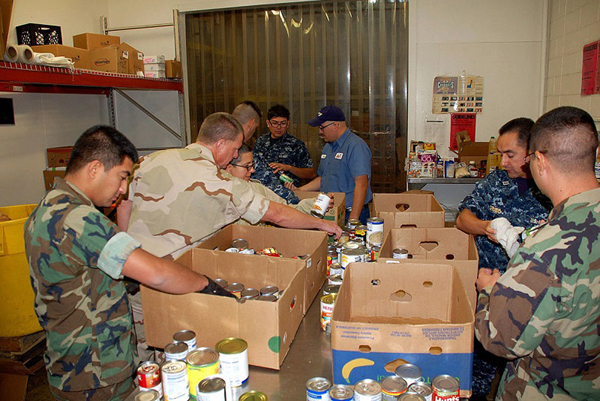- Fragile Planet Offers a Nighttime Wildlife Experience
- Falcons Soccer Off & Running
- Cameron County Receives Funds to Improve Two Parks
- Falcons Complete First Half of 32-6A
- School District to Help out Victims of California Wildfires
- Sand Castle Days Continued Despite Unexpected Weather
- Ready for District
- Discussion of Garbage Dumpster Rates, Agreements Between State & City on Highway Regulations, and More
- 31st Annual Shrimp Cook-Off is Right Around the Corner
- LFHS Cross Country
Study: Texas Has High Rate of Food Insecurity, Hunger
- Updated: May 18, 2018

Military and civilian volunteers help sort and distribute food at the West Texas Food Bank in El Paso, one of 21 regional food banks across the state. Photo: WikimediaCommons
by Mark Richardson
LUBBOCK, Texas – Texas ranks among the top states in the country for food insecurity, according to a new report, with more than 4.3 million people who may not know where their next meal is coming from.
The report, “Map the Meal Gap,” also finds that the Lone Star State has an especially high number of children, about 1.7 million, who regularly face hunger.
Food insecurity means a person regularly lacks access to enough food for an active, healthy life.
Celia Coles, CEO of Feeding Texas, says a simple formula defines the problem: Poverty equals hunger.
“Food insecurity is very linked to economic insecurity, and so any time you have a county that’s got a high rate of poverty and unemployment and other things, you’re going to see higher rates of food insecurity,” she states.
The report, produced by Feeding America, a national coalition of food banks, finds that more than 41 million – 1.8 Americans – often struggle to get enough to eat. Of that total, 13 million are children.
Coles adds that it would take almost $2 billion a year to close the current meal gap for food-insecure Texas families.
Coles says that while food insecurity affects a large number of people, it impacts some groups of Texans more than others.
“It’s more prevalent among specific populations,” she points out. “We know that kids are more likely to face food insecurity. Seniors face higher rates of food insecurity, people with limited English proficiency, immigrant communities. And again, that’s linked to economic insecurity.”
Coles says there is deep concern among advocates over the current debate in Congress on proposed cuts to the Supplemental Nutrition Assistance Program (SNAP).
“If you look at the population that’s suffering food insecurity in Texas, it’s estimated that about a third of them aren’t eligible for those federal nutrition programs because their incomes are slightly above the limit,” she states.
Coles says the Feeding Texas network of 21 regional food banks distributed more than 300 million pounds of food to local communities last year, but that much more is needed.
